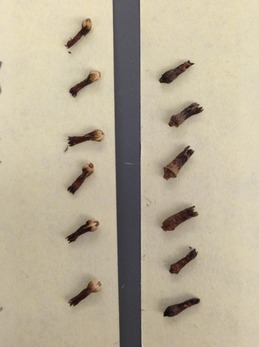While it may seem obvious, here at the Echinacea Project we look at a lot of Echinacea. With such large numbers–thousands of plants each summer and heads each winter– we’re used to a certain degree of variation. Bracts differ in length and degree of “pokey-ness”, trichome density varies among leaves, and achenes range in size and color (see the post “A Palette of Pallida” from March 21st for an example).
This morning one of our volunteers, Suzie, noticed that the florets on the head she was cleaning had a distinctly different shape and color. The florets come from CG-6152 wht, or plant 27, 915 in the quantitative genetics (qGen) section of the common garden. Below is is a side by side view of these unusual florets (on the left) compared with what we typically see.
This is the first time we’ve seen this sort of variation in floret shape and color in the lab. Right now we can’t say for certain what caused it, whether it’s natural variation or a response to insect herbivory, for example. It’ll be interesting to visit this plant next year, however, and see if this variation persists and is conspicuous when the plant is flowering.


Leave a Reply